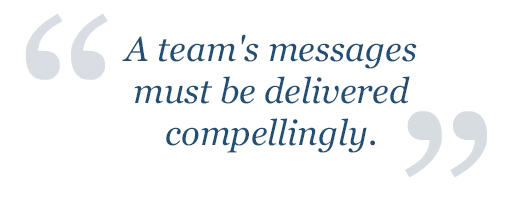Developing a communication strategy for the AdComm meeting is a critical first step toward achieving AdComm success and underlies the rest of the preparation process. An effective communication strategy shapes how the company structures the presentation and Briefing Document, designs the visuals, and words key phrases. Thus a focused and realistic strategy can make the difference between a positive and negative vote.
It will guide the progress of the key messages that drive communication with the Advisory Committee. Thus it's critical that every element of the communication be aligned with these messages. Failure of alignment can undermine the entire process, eroding the team's effectiveness and credibility with the Committee. The preparation team needs to adhere to the strategy to enable it to craft the clear and consistent messages through which they will persuade the Committee.
To construct a forceful communication strategy, the team must first discuss and agree on the specific outcomes it needs to achieve at the meeting. Outcomes may range from positive votes on safety and efficacy to specific phrases that they want members of the Committee to say during the meeting. By defining outcomes at this level of granularity and relating them back to the desired indication and claims, the team can maximize its potential for success at the Advisory Committee meeting.
Desired outcomes need to be strongly supported by the data. Everyone can interpret data differently, so it's important to base the team's goals on what the data can readily support. Success usually hinges on choosing conservative goals that the team will be able to persuade the committee to support without compromising its credibility.
Messaging begins as the team defines its desired outcomes for the meeting and adjusts these outcomes to what is realistic given its analysis of the Committee. From these revised outcomes, team members develop a preliminary set of messages designed to convince this specific audience that acceptance of the desired incomes is warranted. These initial messages form the basis of the argument that the team will use to persuade the committee.
Then begins a guided progression of subsequent revising and editing as the team receives and evaluates feedback focused on the substance, importance, and power of the initial messages. The team continues to evolve argument and messages, each iteration bringing both closer to achieving its defined goals. Using this measured, iterative approach, the team carefully develops compelling messages to support the defined outcomes it seeks from the Committee.
The steps of this messaging process help the team shape every communication it prepares for the Advisory Committee: the Briefing Document, Core Presentation script and slides, responses to questions from internal and external experts, and the composition of any back-up slides used to support those responses. An effective communication strategy further ensures that the substance of these components is aligned, that their arrangement is prioritized, and that each message is appropriately emphasized and supported.
Optimizing the team's chances of success requires a thorough understanding of the audience it will face. Without understanding how the audience will perceive the data, the team cannot prepare effectively for an Advisory Committee meeting. By performing a detailed analysis of each Committee member's interests and concerns, the team can start to identify the messages that will resonate most with each member of the Committee. Team members can also begin to anticipate likely questions, both in core content and Q&A periods. By refining their understanding of the people on the committee, the team can define further the messages that will bring this particular group to the team's desired outcomes.
Once they have defined their initial messages, team members will need to repeatedly test and refine them. The first test usually takes the form of an internal attack, with the entire team turning on itself to test the strength of its messages. Through this process, it can refine and strengthen each message as well as anticipate questions based on the weaknesses identified in their attack. After this initial refinement of raw messages, the team can begin to shape them into key communication elements to be used to reach the Advisory Committee: the Briefing Document, Core Presentation script, and written responses to questions. Undertaking these in parallel, based on the same set of messages, the team will assure that the end results will be consistent and congruent representations of a single communication strategy.

Once the team has attacked its own messages and refined them based on the weaknesses discovered internally, it is ready to test and revise those messages by inviting external experts to provide their feedback on the messages.
Mock Advisory Committee meetings, scheduled throughout the preparation process, provide a powerful means of delivering external feedback. By choosing mock panelists who are naïve to the study results but are similar to those who will serve on the Committee, the team will receive a realistic perspective on how the actual Committee will respond to the team's argumentation. The first mock needs to occur early enough to protect the team from wasting time developing ineffectual argumentation. Getting external feedback on the initial drafts of the Core Presentation, Briefing Document, and responses to Q&A sessions will help ensure that the team is on the right path. Subsequent mocks will then enable it to test each iteration while also generating questions to prepare for and responses to practice.
Having endured the heat of a series of tough mock panels, each message will be able to stand on its own at the meeting. Gathered together and organized strategically into a compelling argument, these messages can form the foundation of success at the meeting. The argument needs to be clearly articulated, with strong linkages from one message to the next. It also has to be consistent in its every form, the Briefing Document text and figures, the presentation script and slides, and the responses and any supporting slides during Q&A.
A team's messages must be delivered compellingly. Ongoing rehearsals and the mocks will help the team not only develop their content but hone their delivery; this critical intersection of message strategy and team preparation will enable a team to reach the goals it has defined. Advisory Committee success requires well-planned, practiced, and precise delivery of a strategically focused persuasive argument by skilled communicators. They are thus enabled to present the study results and address questions with the greatest impact.
By the time the team gets to the Advisory Committee meeting, it should embody its communication strategy. Every member of the team should be able to meet his or her specific responsibility in executing the strategy, whether by pulling up the right slide, delivering key messages with personal conviction, or responding credibly to tough questions.
Every element of communication with the Committee needs to be crafted with the audience and outcomes in mind, following the same strategy and messaging throughout. As simple as that may sound, teams often stumble by falling back to prior submissions or presentations, grabbing material from multiple sources. The result can be confusing and even contradictory.

Nothing can crush a team's credibility with an Advisory Committee as rapidly as inconsistencies in messages, graphics, or data. What should a team do with new safety findings from ongoing studies that were not included in the original submission? What happens if a chunk of text grabbed from the Clinical Overview contains outdated information? What if a response to a question contradicts a key element of the Core Presentation? These are the sorts of issues that can arise if the team does not focus its efforts and coordinate its communication strategy throughout the preparation process.
By starting with a communication strategy built around the specific concerns of the Committee and then designing clear and consistent messages within its parameters, the team optimizes its chances of achieving its goals at the Advisory Committee meeting.





